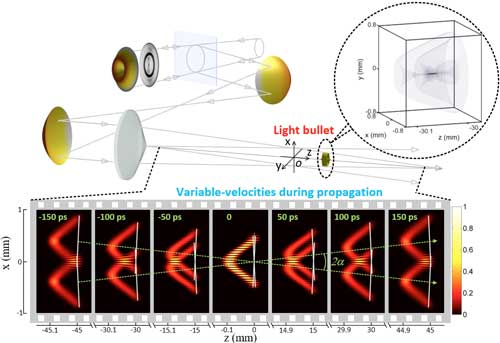| Dec 14, 2020 |
Not so fast! Controlling the speed of light bullets
(Nanowerk News) Though it sounds like something straight out of science fiction, controlling the speed of light has in fact been a long-standing challenge for physicists. In a study recently published in Communications Physics ("Optical wave-packet with nearly-programmable group velocities"), researchers from Osaka University generated light bullets with highly controllable velocities.
|
|
According to Albert Einstein's principle of relativity, the speed of light is constant and cannot be exceeded; however, it is possible to control the group velocity of optical pulses.
|
|
Currently, the spatiotemporal coupling of optical pulses provides an opportunity to control the group velocity of three-dimensional non-diffraction optical wave-packets, known as “light bullets,” in free space.
|
 |
| Flying light bullet with variable-velocities (see beam center). (Image: Osaka University) (click on image to enlarge)
|
|
In their previous study (Scientific Reports, "Velocity and acceleration freely tunable straight-line propagation light bullet"), this group found that by deforming the pulse-front of optical pulses and keeping the phase-front unchanged, the velocity and the acceleration of the generated flying Bessel-Gaussian (diffraction- and dispersion-free) light bullets can be controlled.
|
|
“However, the problem is that only one determined motion form, for example, superluminal or subluminal for velocity and accelerating or decelerating for acceleration, can be achieved in a single propagation path,” explains corresponding author Zhaoyang Li.
|
|
In this newly improved method, by using the combination of a deformable mirror and a spatial light modulator, the pulse-front of optical pulses can be arbitrarily deformed, which results in light bullets with arbitrarily-variable velocities (and accelerations) during a single propagation path; e.g., subluminal followed by superluminal and/or accelerating followed by decelerating.
|
|
“This non-diffraction light bullet with nearly-programmable flying velocities may bring new opportunities in a wide range of applications, such as free-space communication, bio-imaging, optical detection and processing, particle acceleration and manipulation, radiation generation, among others,” says Zhaoyang Li.
|

